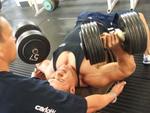 |
Fatigue is a part of life and we're all familiar with it. But it can be difficult to describe and people express it in a variety of ways, using terms such as tired, weak, exhausted, weary, worn-out, fatigued, burnt out, wiped, etc. Health professionals describe fatigue using terms such as asthenia, fatigue, lassitude, prostration, exercise intolerance, lack of energy, and weakness. |
Generally we can put the many ways that people express and experience fatigue into two categories, physical and mental. Although these two kinds of fatigue are sometimes difficult to separate and aspects of each can be involved when one feels tired, they're separate enough in most of our minds. Physical fatigue is just that, our physical bodies are tired because of either too much physical work, including not enough time to recover from physical work, or lack of sleep, including jet lag. Mental fatigue can occur when we're emotionally or psychologically worn out and not coping with the stresses and strains in our lives.
In a nutshell we have limited amounts of energy and reserves, and when these are taxed, either physically or mentally, or more commonly both, we experience fatigue. And when we're fatigued we need to recharge our batteries in one way or another. We deal with the fatigue of our active days and physical activity by resting and by getting a good night's sleep. If we don't rest enough or get enough sleep then we suffer from fatigue until we do. In a way it's the same with mental fatigue only in this case we need to get some relief from whatever is causing it. In some cases, such as in chronic fatigue syndrome, the two types of fatigue run in together and we get debilitating mental and physical fatigue.
As well, certain medical conditions cause fatigue. A common example, especially in women, is anemia. Other causes of fatigue include chronic illness, heart and lung problems, cancer, diabetes, hormonal disorders, and a variety of other conditions. If you experience chronic fatigue then the first thing you should do is see your doctor and make sure everything is OK.
 |
While we could go on ad infinitum about the different causes and effects of fatigue and how to deal with them, we're going to limit the discussion in this article to the fatigue associated with exercise. What it is, why it happens and what we can do about it. |
Assuming that there are no underlying problems, then we can divide the fatigue that we experience as a result of exercising into two types, peripheral and central. While the research in the area of fatigue has focused mostly on peripheral fatigue, research in central fatigue has been increasing although it mostly revolves around serotonin and the central fatigue hypothesis.
Peripheral fatigue deals with the capacity of muscle to do physical work. In this type of fatigue we're dealing with an impairment in the normal functioning of the nerves and muscles involved in muscle contraction. This covers the gamut from the transmission of the impulses from nerves to muscle to the actual contractile apparatus of the muscle itself.
Central fatigue, on the other hand, involves the central nervous system, from our brain to the connections to the nerves that are involved in muscle contraction. Central fatigue can be the result of changes in various neurotransmitters in the brain secondary to changes that occur in the body and mind.
Most fatigue associated with exercise usually involves some degree of both peripheral and central fatigue. The degree that each is involved is often difficult to determine as the contribution of each to fatigue may vary between activities and even within the same activity. For example, when doing a multiple sets of an exercise using weights, the fatigue in the initial sets taken to failure may be mostly peripheral, while the fatigue experienced in later sets may more of a central component.
The problem with examining fatigue associated with a bodybuilding type of weight training, is that it's not necessarily valid to extrapolate from studies on fatigue done using endurance or high intensity exercises that have different execution variables. For more information on these variables and their applicability to bodybuilding see the well done recently published review on the application of studies done on fatigue to bodybuilding.
 |
Peripheral Fatigue - The mechanisms of fatigue within muscle (peripheral fatigue) are well studied and include impairments in neuromuscular transmission and propagation down the sarcolemma, dysfunction within the sarcoplasmic reticulum involving calcium release and uptake, availability of metabolic substrates and accumulation of metabolites, and actin-myosin cross bridge interactions. |
The more important causes of physical fatigue, in my view, have to do with 1. systemic changes such as overheating and dehydration. And 2. the availability and accumulation of various compounds.
1. Systemic factors that may cause peripheral fatigue
Dehydration - While not as important as in endurance events, dehydration can cause fatigue even with resistance training. Dehydration doesn't have to be extreme to impair performance and as little as a three to four pound loss of water weight (something that's not too hard to imagine in a vigorous workout) can increase fatigue.
Pure water is not the best way to rehydrate during and after exercise. To restore the body fluids you sweat out during exercise, you should consume a beverage that contains some appropriate electrolytes, including sodium and potassium, and some glucose and perhaps a buffering agent. Sodium and potassium are volumizing agents and help to maintain blood volume and increase the absorption of water from the GI tract. It's important, therefore to drink fluids before, during and after exercise to prevent dehydration and overheating.
Overheating - Body temperature increases with exercise, in some cases as high as 104 degrees even with resistance training. Since large volumes of blood are diverted to the skin to try and cool the body down, the circulatory system may become burdened and result in an increased temperature which in turn results in decreased performance and fatigue.
The best way to deal with this is to make sure you're well hydrated and to decrease clothing worn so that sweat evaporates readily cooling the body off.
2. The availability and accumulation of various substrates, metabolites and metabolic byproducts.
First of all it's important that there are no vitamin or mineral deficiencies as these can impact on performance and cause fatigue. For example, even marginal deficiencies in potassium, calcium, magnesium and zinc can cause fatigue, as can deficiencies of various vitamins including the B vitamins, folate, vitamins A, C and E.
It's useful to examine the changes that take place in the muscle during exercise and compare these changes with the resting condition. As well, we can suggest ways in which any changes that may impact on performance and fatigue can be corrected, and as such reverse the fatigue and decreased performance.
Changes that take place with exercise over the resting state include:
- Decreased ATP levels
- Decreased levels of phosphocreatine (PCr)
- Increased levels of ADP and Pi
- Increased pH or acidity
- Increased lactate concentrations
- Increased ammonium levels
- Decreased muscle glycogen
- Strategies to combat fatigue
Based on the principle in which any differences from the resting state may be responsible for fatigue and decreased performance, one way to determine the cause or causes of fatigue, although limited, is to increase or decrease the concentration of a substrate which is depleted with exercise but is required for contraction or the absence or accumulation of substance that may fatigue. Keep in mind that because it's likely that a number of changes are responsible for fatigue, there may be a number of individual strategies that will have an effect on decreasing fatigue. In all likelihood, the best approach to combating fatigue is one in which a variety of strategies are combined. Some of the more popular strategies are:
* Creatine ingestion with the purpose of increasing PCr levels in the muscle cells, along with an increased ability to form PCr when needed. The ingestion of creatine, usually in the monohydrate form has been shown to increase levels of both creatine and PCr in muscle cells, and to result in increased performance and decreased fatigue. Interestingly enough a recent study has also shown that creatine supplementation also reduces mental fatigue in humans.
* Use of a buffer solution to combat the acidosis. Several studies have implicated acidosis as a likely cause of fatigue, especially during high-intensity intermittent exercise and likely during high volume resistance training. In my view and according the literature, buffer solutions that might prove useful are ones containing either bicarbonate or the non bicarbonate natural buffers of vertebrate muscle including inorganic phosphate, protein-bound histidine residues, and the dipeptide carnosine.
* Increasing muscle glycogen content and increasing the use of free fatty acids as the primary muscle fuel. Using strategies to maximize glycogen levels but restricting the use of glycogen for those times when it's needed the most, the times when only anaerobic energy has to be produced, and fat adapting muscle so that fat is used as the primary fuel, increases performance and decreases fatigue.
Use of antioxidants - Oxidant and radical damage to skeletal muscle membranes has been implicated in the fatigue process and several studies have found that the use of antioxidants, such as vitamin E, increases muscle contractile force and decreases fatigue.
Central Fatigue
In addition to focusing on the causes of muscle fatigue, recent research has also centered on mental fatigue during exercise. This is commonly called central fatigue because it results from impaired function of the central nervous system. Although central fatigue does not affect your muscles directly, it can reduce your capacity to perform.
The basis behind the central fatigue hypothesis is the theorized correlation between levels of the amino acid tryptophan in the brain, which is a precursor for the neurotransmitter serotonin, and the degree of mental fatigue. When tryptophan enters the brain, it leads to increases in serotonin levels, which can depress the central nervous system, causing sleepiness and fatigue.
 |
One of the ways that has been suggested for fighting off the increases in tryptophan entering the CNS is the use of branched chain amino acids (BCAA) during exercise. Most of the blood tryptophan in the body is loosely bound to albumin, one of the blood proteins, with a certain amount free. |
| |
|
The free tryptophan is transported, along with other amino acids (such as the branched chain amino acids leucine, isoleucine and valine) into the CNS. Thus tryptophan levels in the brain, and subsequently serotonin levels, increase when there is an increased ratio of free tryptophan to the total BCAA concentration. The more BCAA present the less tryptophan enters the brain and less serotonin is produced. The end result is less central fatigue. The process is much more complicated than what I've just described and there are many other players that can influence brain serotonin levels. Also there is still some controversy about whether the central fatigue hypothesis is even valid. Nevertheless, there are now intriguing theories and some evidence to support a possible role of nutrition in central fatigue during rest and exercise.
Stimulants - One of the ways to combat fatigue, both central and peripheral, is through the use of stimulants such as caffeine and ephedrine, either alone or in combination. Studies have shown that these compounds are effective in increasing both strength and endurance, and in allaying fatigue.
The bottom line is that using several of the strategies I've mentioned will help you combat fatigue and make your training more productive and satisfying.
References:
1 Lambert CP, Flynn MG. Fatigue during High-Intensity Intermittent Exercise: Application to Bodybuilding. Sports Med 2002; 32(8):511-522.
2 Enoka RM, Stuart DG. Neurobiology of muscle fatigue. J Appl Physiol 1992; 72(5):1631-1638.
3 Vandenberghe K, Goris M, Van Hecke P, Van Leemputte M, Vangerven L, Hespel P. Long-term creatine intake is beneficial to muscle performance during resistance training. Journal of Applied Physiology 1997; 83:2055-2063.
4 Volek JS, Kraemer WJ, Bush JA et al. Creatine supplementation enhances muscular performance during high-intensity resistance exercise. Journal of the American Dietetic Association 1997;97:765-770.
5 Watanabe A, Kato N, Kato T. Effects of creatine on mental fatigue and cerebral hemoglobin oxygenation. Neurosci Res 2002 Apr;42(4):279-85.
6 MacDougall JD, Ray S, Sale DG McCartney N, Lee P, Garner S. Muscle substrate utilization and lactate production during weightlifting. Canadian Journal of Applied Physiology 1999; 24:209-215.
7 Coombes JS, Rowell B, Dodd SL, Demirel HA, Naito H, Shanely RA, Powers SK. Effects of vitamin E deficiency on fatigue and muscle contractile properties. Eur J Appl Physiol 2002; 87(3):272-277.
8 Jakeman PM. Amino acid metabolism, branched-chain amino acid feeding and brain monoamine function. Proc Nutr Soc 1998; 57(1):35-41.
9 Graham TE. Caffeine and exercise: metabolism, endurance and performance. Sports Med 2001; 31(11):785-807.
10 Bell DG, Jacobs I, Zamecnik J. Effects of caffeine, ephedrine and their combination on time to exhaustion during high-intensity exercise. Eur J Appl Physiol Occup Physiol 1998; 77(5):427-33.
by Dr. Mauro Di Pasquale









